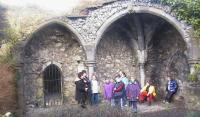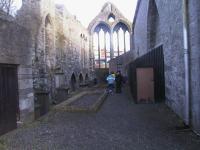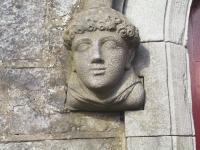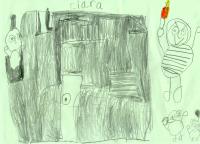| Early
in the 13th Century, Earl Marshall who was a Norman Lord
and who had built Kilkenny Castle decided to build a new
monastery for the monks in John St. near John's Bridge.
The 1st building to be built was the abbey, and on Dec
27th 1220, on the Feast of St. John, mass was celebrated
for the 1st time on the high altar of the new abbey. The
other buildings around the abbey including the hospital
were not completed until over a hundred years later. In
the meantime the monks continued to live in their original
site at Greensbridge. It must have been quite a substantial
building project as it took 100 years to complete. |
|
|
|
A Bishop called Felix O'Dullany,
who died in 1202, brought to Kilkenny monks called the
Brethren of the Hospital of St. John. The monks liven
in Teampall na Maul at Greens Bridge beyond where the
swimming pool now stands. Nothing remains of the monastery
today.
The picture to the left
shows Mrs. Ryan and two of her students. The mound to
the right is the site of Teampall na Maul.
|
| It was 1325 when the monks
moved to their new buildings in St. John's Abbey. This
monastery was at first a hospital for the poor and the
sick around Kilkenny. The new abbey was a walled monastery
and was quite a large compound. All the lands around Michael
Street and all along the banks of the river Nore to Greensbridge. |
 |
 |
The only part left of these
other buildings within the monastery is the monumnet in
Mrs. Ryan's front garden. It seems to have been a small
church or oratory which is about 100 yards to the west
of the main church. It may have been attached to the Priors
House because the land between it and the river is still
known as Prior's Orchard to this day. |
| During the time of the Crusades
the monks changed their name to Knights Militant by order
of the Pope. The monks were to help to recover the Holy
Lands from the Turks, who were not christians, as well
as looking afterthe sick and poor of Kilkenny. The Knights
practised for battle up and down the river bank on horseback.
They also looked after pilgrims who were on their way
to defend the Holy Land. |
 |
 |
In the 16th Century the Priory
was taken from the monks by Henry VIII of England during
the Reformation and given to the Mayor and people of Kilkenny.
Henry, not the pope, became head of The Church of England
and so began the division between Catholics and Protestants. |
| The abbey building survived
for the best part of two centuries after that. In the
17th Century the Jesuits used it as a college, but shortly
after this the abbey wasn't used and had fallen into disuse
and ruin. |
 |
 |
In 1780 the nave of the church
and the other buildings were knocked down and the stones
used to build a Military Barracks where Evans' Home now
stands. This photograph shows our class standing at the
entrance to Evans' Home. |
| In 1817 The Lady Chapel was
re-roofed by the Church of Ireland and is used as a Protestant
Parish Church and is now called St. John's Church even
to this day. |
 |
 |
Only part of the original
priory remains today. It is at the back of St. John's
Church. The Priory was known as the Lantern of Ireland,
because it had such a number of beautiful windows. The
surving east window dates from 1300. There are several
ancient monumnets and tombs in the present church grounds. |
| |
|
| |
|
| The following pictures of
St. John's Priory were drawn by pupils of Junior 6 following
our visit. |
|
| |
|
 |
 |
 |
 |
 |
 |


